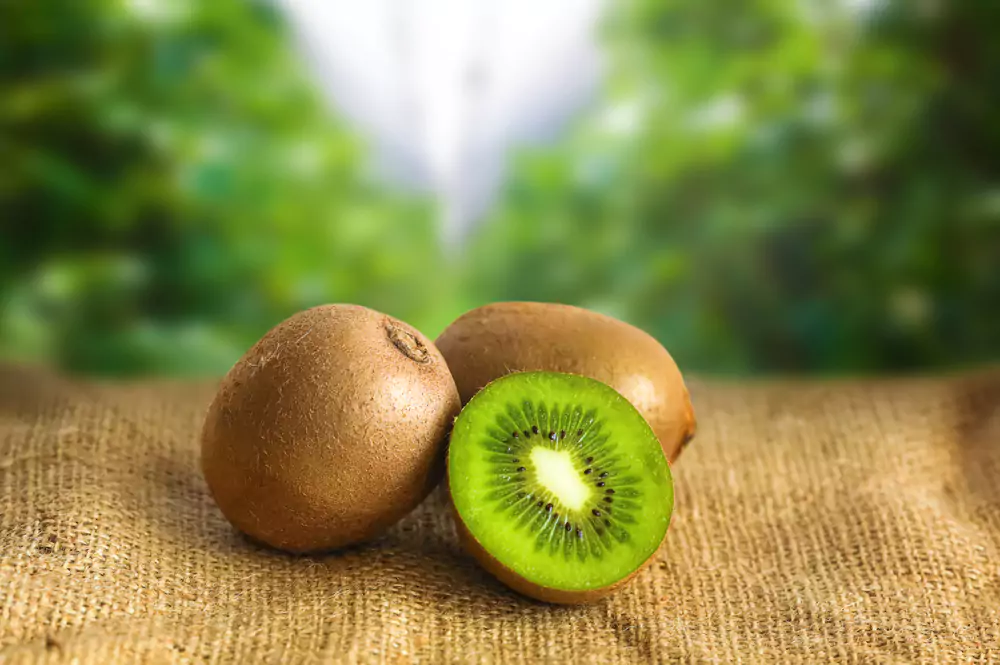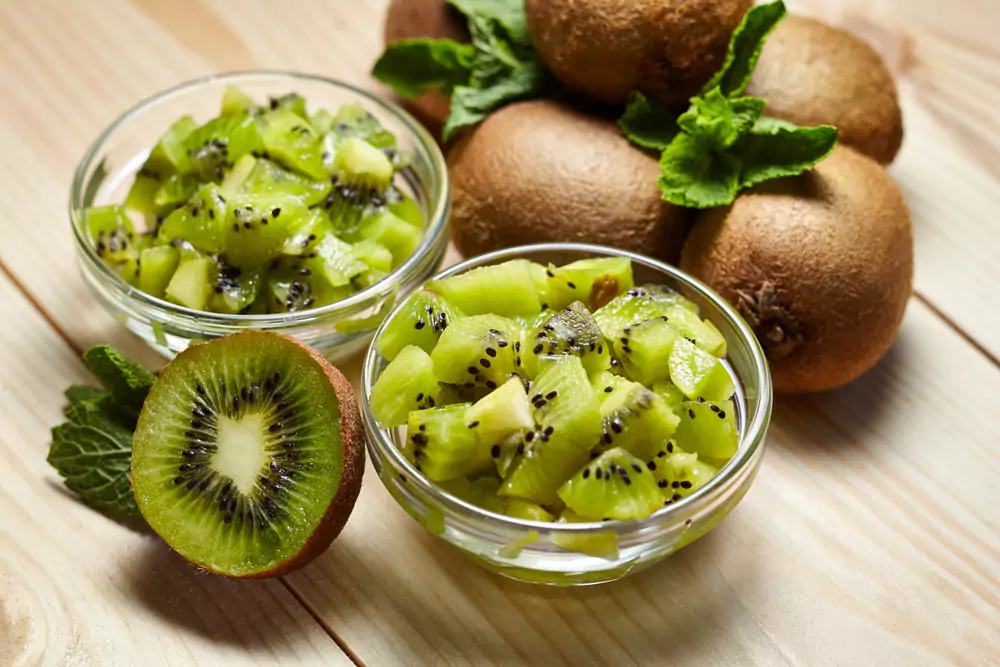When it comes to fruits, there is always something new to learn and explore. One such fruit that has caught the attention of many is the kiwi fruit. Often referred to as a “citrus,” there is a common misconception about its true classification.The confusion around ‘’Is kiwi fruit citrus? ‘’stems from the fact that it shares some characteristics with citrus fruits, such as a similar taste and the presence of vitamin C.
However, kiwi fruit belongs to a different botanical family, which is Actinidiaceae, while citrus fruits belong to the Rutaceae family. This distinction is essential in understanding the true nature of kiwi fruit and differentiating it from other fruits.
In this blog post, I will dive into the topic of kiwi fruit and determine whether it is indeed a citrus or not.
So let’s get started!
Is Gold Kiwi A Citrus Fruit?
Well, gold kiwi is not a citrus fruit. It is actually a type of berry that has a sweet and tropical flavor. I have tasted gold kiwi before, and it’s juicy and vibrant flesh is quite different from the tangy and acidic taste of citrus fruits like oranges and lemons.
Is Kiwi A Tropical Fruit?
Do you know that the kiwi fruit is often mistaken as a tropical fruit due to its exotic appearance and origins? However, in reality, it is not a tropical fruit.

Kiwis actually belong to the genus Actinidia, which is native to temperate regions in Asia, primarily in countries like China and Japan. They thrive best in cooler climates and are not suited for the hot and humid conditions typically associated with tropical regions.
While it is true that kiwis have a subtropical cousin, the yellow kiwi or Actinidia chinensis, the most common variety, the green kiwi or Actinidia deliciosa, does not. The green kiwifruit is best suited for cooler climates and is predominantly grown in countries like New Zealand and Italy.
What Does Kiwi Taste Like?
Well, in terms of taste, kiwi is a unique fruit that offers a delightful combination of sweet and tangy flavors. The flesh is juicy and succulent with a hint of tropical sweetness, reminiscent of strawberries, melons, and bananas. The black seeds add a crunchy texture and a slightly nutty flavor. Overall, the taste of kiwi is refreshing and vibrant, making it a delicious addition to fruit salads, smoothies, or enjoyed on its own.
Is Kiwi More Acidic Than Oranges?
You might be wondering, is kiwi more acidic than oranges? To answer this question, let’s dive into the fruit’s pH levels and compare them.
First, let’s understand what pH levels are. pH is a scale used to measure the acidity or alkalinity of a substance, ranging from 0 to 14. A pH level of 7 is considered neutral, while values below 7 indicate acidity, and values above 7 indicate alkalinity.
Now, let’s compare kiwi and oranges. Kiwi, with its bright green flesh, has a pH level of around 3.0, which makes it quite acidic. On the other hand, oranges, with their juicy and sweet taste, have a pH level of approximately 3.5. While both fruits are acidic, oranges are slightly less acidic than kiwis.
Is Kiwi Fruit A Berry?
Yes, kiwi fruit is a berry. I know that because I have researched and learned that a berry is defined as a fleshy fruit produced from a single ovary. The kiwi fruit meets this definition as it develops from a single flower with one ovary, and its inner flesh is surrounded by seeds. Additionally, botanically speaking, berries have seeds distributed throughout the flesh, which is also true for kiwi fruit. Therefore, based on my understanding and personal research, I can confidently say that kiwi fruit is indeed a berry.
Is Kiwi A Vegetable?
No! Kiwi is not a vegetable. Kiwi is actually a fruit. I learned this from my biology classes in school. Kiwi is a berry that grows on a woody vine and is known for its fuzzy brown skin and bright green flesh with black seeds. It’s rich in vitamin C, vitamin K, and dietary fiber. So, while it may not be a vegetable, it’s definitely a delicious and nutritious fruit!
Benefits Of Kiwifruit
First thing first, kiwi is a small, oval-shaped fruit that is packed with numerous health benefits. It is rich in vitamins, minerals, and antioxidants, making it a popular choice for those who want to improve their overall health.

Here are some of the benefits of kiwi fruits you need to know:
Improves Gut Health
Kiwifruit is an excellent source of dietary fiber, which is essential for maintaining a healthy digestive system. The fiber content in kiwifruit helps to prevent constipation and promotes regular bowel movements, ensuring smooth digestion and proper functioning of the gut. Furthermore, the fruit’s prebiotic properties support the growth of good bacteria in the gut, thus enhancing overall gut health.
Boosts Immunity
Kiwifruit contains a high amount of vitamin C, an essential nutrient that plays a crucial role in boosting the immune system. Vitamin C helps the body fight against infections, viruses, and harmful pathogens. It also aids in the production of white blood cells, which are responsible for defending the body against diseases.
Promotes Heart Health
Kiwifruit is rich in potassium, an essential mineral that helps maintain a healthy balance of fluids in the body. Potassium also supports proper nerve and muscle function, and it helps lower blood pressure by counteracting the effects of sodium. Additionally, kiwifruit contains antioxidants like vitamin E and vitamin C, which help protect the heart by reducing inflammation and preventing oxidative stress.
Types Of Kiwi
Now that you have detailed information about kiwi, let’s see the different types of kiwis that exist.

Green Kiwifruit (Actinidia deliciosa)
This is the most common type of kiwi, known for its green, fuzzy skin and sweet, tangy flavor. It is native to China and was introduced to New Zealand in the early 20th century.
Golden Kiwifruit (Actinidia chinensis)
Also known as the yellow kiwi or sunshine kiwi, this variety has a smooth, golden-yellow skin and a sweeter, less acidic taste compared to the green kiwi. It is native to China and has been cultivated for centuries.
Silver-Veined Kiwifruit (Actinidia arguta)
This type of kiwi is smaller than the green and golden varieties, with a smooth, silver-colored skin. It has a sweet, delicate flavor and is often used in Asian cuisine.
Arrow Kiwifruit (Actinidia kolomikta)
This rare type of kiwi has a combination of green, yellow, and silver-veined skin patterns. It is smaller in size and has a mild, sweet flavor.
Purple Kiwifruit (Actinidia purpurea)
Native to China, this kiwi variety has a purple-brown skin and a sweet, aromatic flavor. It is less common and can be difficult to find in markets.
Red Kiwifruit (Actinidia eriantha)
This kiwi has a red skin and a sweet, tropical flavor. It is native to China and is less common than other varieties.
Brown Kiwifruit (Actinidia melanandra)
Also known as the hardy kiwi or grape kiwi, this type has a brown skin and a grape-like texture. It is native to North America and is often used in salads and desserts.
Fun Facts About Kiwi Fruits
You will be surprised to know that kiwi fruits have some fascinating facts that make them not just a delicious snack, but also a nutritious one. Here are 5 fun facts about kiwi fruits that you might find interesting.
Kiwi Fruit Origins
Did you know that kiwis are not originally from New Zealand? Although the country adopted the fruit as its national symbol, kiwis actually originated in China. They were brought to New Zealand in the early 20th century.
Varieties of Kiwis
There are two main varieties of kiwi fruits: the green kiwifruit, which is also known as the Actinidia deliciosa, and the golden kiwifruit, which is known as the Actinidia chinensis. Both varieties have a similar taste and texture but differ in color and appearance.
Nutritional Powerhouse
Kiwi fruits are packed with essential vitamins and minerals. They are an excellent source of vitamin C, vitamin K, and vitamin E. Additionally, kiwi fruits are rich in potassium, which helps regulate blood pressure, and dietary fiber, which promotes digestive health.
Seedless Wonder
Most people are familiar with the green kiwi fruit, which has small, black edible seeds. However, there is also a seedless variety of kiwi known as the ‘Hayward’ cultivar. This variety has been selectively bred to have fewer seeds, making it more appealing to those who prefer a smoother texture.
Health Benefits
Kiwi fruits offer numerous health benefits. They are known to boost the immune system, improve digestion, and promote heart health. The antioxidants found in kiwi fruits can also help reduce inflammation and protect against chronic diseases.

What Kiwifruit And Citrus Fruit Have In Common?
Well, do you know that kiwifruit and citrus fruit actually have quite a few things in common? As someone who loves fruits and has done some research on the topic, I can share some interesting similarities between these two types of fruits.
Nutritional Content
Both kiwifruit and citrus fruits are packed with essential nutrients. They are excellent sources of vitamin C, which is known for its immune-boosting properties. Additionally, they contain dietary fiber, which is important for digestive health. Both types of fruits also provide a range of vitamins and minerals that contribute to overall well-being.
Acidic Nature
Another common trait between kiwifruit and citrus fruit is their acidic nature. This acidity gives them a tangy flavor profile that many people enjoy. It also contributes to their versatility in culinary applications, as they can be used to add a refreshing zing to both sweet and savory dishes.
Variety of Types
Kiwifruit and citrus fruit come in various types and flavors. For example, within the citrus family, you have oranges, lemons, limes, grapefruits, and more. Similarly, kiwifruit also has different varieties such as green kiwi, gold kiwi, and even red kiwi. This diversity allows for a wide range of taste experiences and nutritional profiles within each fruit category.
Versatile Culinary Uses
Both kiwifruit and citrus fruit are incredibly versatile in the kitchen. They can be enjoyed fresh on their own, added to fruit salads, used in smoothies, or incorporated into desserts such as tarts and cakes. Additionally, their juice can be used in marinades or dressings to add brightness to savory dishes.
Growing Conditions
Kiwifruit and citrus fruit thrive in similar growing conditions. They both prefer temperate climates with well-drained soil and ample sunlight. This shared preference for specific environmental factors makes them suitable for cultivation in many of the same regions around the world.
Why Is Kiwifruit And Citrus Fruit Different?
Well, there are many reasons why kiwifruit and citrus fruits are different. Let’s discuss some of these differences in detail:
Differences in Appearance
One of the most noticeable differences between kiwifruit and citrus fruits is their appearance. Kiwifruit, also known as Chinese gooseberry, has a brown, hairy exterior that may be off-putting to some people. In contrast, citrus fruits like oranges, lemons, and grapefruits have a smooth, brightly-colored skin that is more visually appealing.
Differences in Taste
Another significant difference between kiwifruit and citrus fruits is their taste. Kiwifruit has a sweet and tangy flavor with a slight hint of fuzzy texture due to its numerous small seeds. On the other hand, citrus fruits like oranges and grapefruits have a sweet, juicy taste with a high vitamin C content.
Differences in Nutritional Value
While both kiwifruit and citrus fruits are rich in essential nutrients, they have different nutritional profiles. Kiwifruit is an excellent source of vitamin C, vitamin K, and vitamin E, as well as potassium and dietary fiber. It also contains a good amount of antioxidants, which can help boost the immune system. Citrus fruits, particularly oranges, are known for their high vitamin C content, which is crucial for maintaining a healthy immune system.
Differences in Uses
Kiwifruit and citrus fruits can be used in various ways, but they have some differences in their applications. Kiwifruit can be eaten fresh, added to salads, or used as an ingredient in smoothies and desserts. It can also be paired with other fruits or used as a topping for yogurt or cereal. Citrus fruits, especially oranges, are often enjoyed as a snack or squeezed into juice, but they can also be used in cooking and baking, adding a tangy flavor to dishes.
Is Kiwi In The Citrus Family?
Know that kiwi is not in the citrus family. I have always been fascinated by fruits and their families, and I know that kiwi belongs to the family Actinidiaceae, while citrus fruits belong to the family Rutaceae. This distinction is important because it affects the genetic makeup, characteristics, and cultivation requirements of these fruits. Understanding the botanical classification of fruits has always been a passion of mine, and I find it intriguing how each family has its own unique traits and properties.
Is Kiwi Good For Acid Reflux?
Personally, I have found that kiwi is good for acid reflux. Kiwi contains an enzyme called actinidain, which aids in digestion and helps break down proteins in the stomach. This can help prevent acid reflux by promoting better digestion and reducing the likelihood of stomach discomfort.
Additionally, kiwi is high in fiber, which can also help regulate digestion and reduce the symptoms of acid reflux. However, it’s important to note that individual experiences may vary, and it’s always best to consult with a healthcare professional for personalized dietary advice.
Is Kiwi More Acidic Than Oranges?
You might be wondering, is kiwi more acidic than oranges? To answer this question, let’s dive into the fruit’s pH levels and compare them.
First, let’s understand what pH levels are. pH is a scale used to measure the acidity or alkalinity of a substance, ranging from 0 to 14. A pH level of 7 is considered neutral, while values below 7 indicate acidity, and values above 7 indicate alkalinity.
Now, let’s compare kiwi and oranges. Kiwi, with its bright green flesh, has a pH level of around 3.0, which makes it quite acidic. On the other hand, oranges, with their juicy and sweet taste, have a pH level of approximately 3.5. While both fruits are acidic, oranges are slightly less acidic than kiwis.
Conclusion
After a thorough analysis of the botanical classification and characteristics of kiwi fruit, it is evident that kiwi fruit is not citrus. Despite its similarities in terms of vitamin C content and tangy flavor, kiwi fruit belongs to the genus Actinidia and is therefore classified as a non-citrus fruit. This distinction is crucial for individuals with citrus allergies or dietary restrictions, as it clarifies that kiwi fruit does not fall within the citrus category.
FAQs
Kiwi Is Citrus Fruit Or Not?
Kiwi is not a citrus fruit; it belongs to the genus Actinidia.
Is Kiwi Acidic Fruit?
Yes, kiwi is an acidic fruit due to its low pH.
What Kind Of Fruit Is Kiwi?
Kiwi is classified as a berry fruit, characterized by its brown, fuzzy exterior and vibrant green flesh with small, edible seeds
Does Kiwi Fruit Have Citrus?
Despite its acidity, kiwi is not a citrus fruit, as it comes from a different botanical family.
Does Kiwi Fruit Have Citric Acid In It?
Kiwi fruit does contain citric acid, contributing to its tart taste and acidic nature.
Is Strawberry A Citrus Fruit?
No, strawberry is not a citrus fruit; it is a member of the rose family.
What Are The Main Characteristics Of Citrus Fruits?
Citrus fruits are known for their juicy, pulpy texture, high vitamin C content, and tangy flavor.
What Are The Benefits Of Kiwi Compared To Citrus Fruits?
Kiwi offers unique benefits compared to citrus fruits, including a high vitamin C content, fiber, and antioxidants, with a distinct taste and texture.
References
- New Zealand Ministry of Health. New Zealand FOODfiles 2014 Version 01. Available from: www.foodcomposition.co.nz/ (accessed 10 January 2017).
- Kader A. and Barrett D. (2004) Classification, Composition of Fruits, and Postharvest Maintenance of Quality. Available online: https://doi.org/10.1201/781420040074.pt1
- USDA national nutrient database for standard reference (release 28). 2015. Available from: https://ndb.nal.usda.gov/ndb/ (accessed 9 January 2017).


![Is Sugarcane A Fruit, Vegetable, Or Grass? [ Answered 2024 ] Is Sugarcane A Fruit](https://juicerhunter.com/wp-content/uploads/2023/10/Is-Sugarcane-A-Fruit-150x150.webp)



